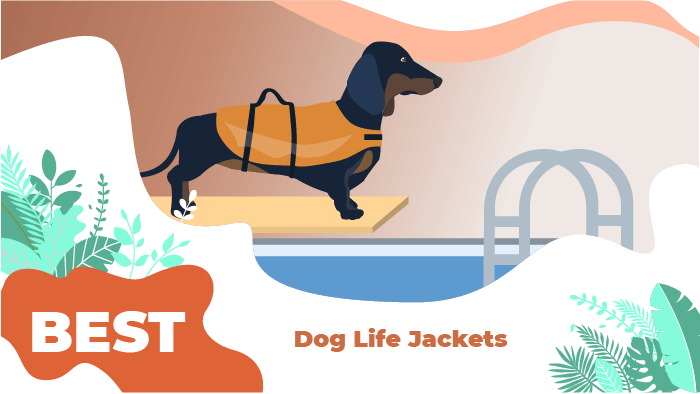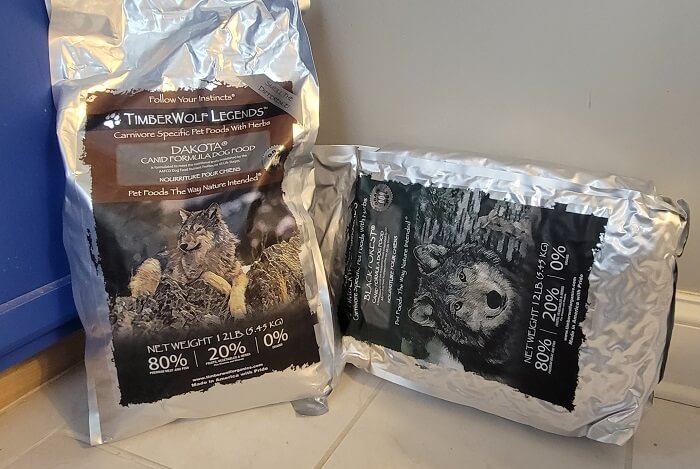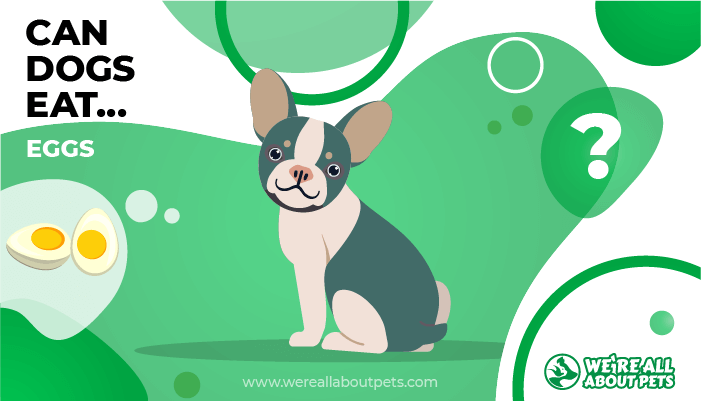Can Dogs Eat Tomatoes?
This page contains affiliate links. We may earn money or products from the companies mentioned in this post through our independently chosen links, which earn us a commission. Learn More
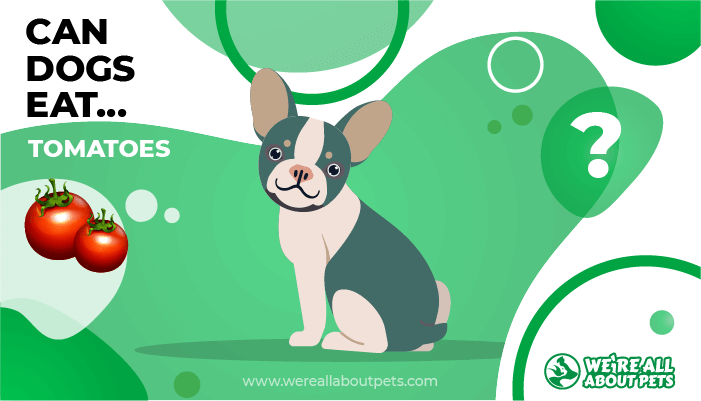
Lush, ripe tomatoes are a favorite with many people in salads, on sandwiches, and in many popular dishes. But can dogs eat tomatoes? Actually, some parts of the tomato plant do contain low levels of some toxic alkaloids.
Nevertheless, the ripe fruit of the tomato is safe for dogs to eat.
You can learn more about tomatoes, their nutrients, and how to give them safely to your dog in our short guide.
Tomato Nutrition Stats
You may know that tomatoes were first cultivated by the indigenous peoples of Mesoamerica. Tomatoes were domesticated by 500 BC, if not earlier. The Spanish took them to Europe.
In Britain they were believed to be poisonous. In Italy they were thought to be ornamental at first.
Today tomatoes are widely used in cuisines all over the world. One cup of tomatoes (149 grams) is considered to be a serving size.
- 26.8 calories
- 1.3 grams protein
- 0.3 grams fat
- 5.8 grams carbohydrates
- 1.8 grams dietary fiber
- Vitamin A 1241 IU (25% daily value)
- Vitamin C 18.9 mg (32% daily value)
- Vitamin K 11.8 mcg (15% daily value)
- Potassium 353 mg (10% daily value)
One averaged-sized tomato has just 22 calories. A large tomato has about 33 calories.
Tomato Nutritional Facts At A Glance
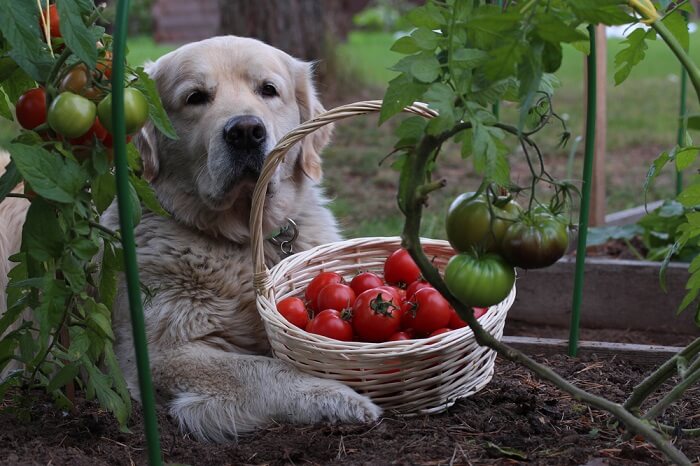
Botanically, tomatoes are a fruit or berry. However, they are typically prepared like a vegetable. Round red tomatoes are most popular but tomatoes come in a wide variety of colors (yellow, orange, green, purple, etc.), shapes, and sizes.
Tomatoes are considered to be very nutritious. They are a good source of vitamin A, vitamin C, vitamin K, potassium, and manganese. They are also a good source of dietary fiber and several other vitamins and minerals such as vitamin E (alpha tocopherol), thiamin, niacin, vitamin B6, folate, magnesium, phosphorus, and copper.
In addition, tomatoes are considered to be good at suppressing the appetite. This is because they contain large amounts of water and fiber.
By percentage, tomatoes contain about 79 percent carbohydrates (which includes fiber), 9 percent fats, and 12 percent protein. Most of the fibers in tomatoes are insoluble such as cellulose, lignin, and hemicellulose.
As with other fruits and vegetables, a large portion of the calories in tomatoes come from sugars such as sucrose, glucose, and fructose, though they are low in calories overall. It is a “culinary vegetable” because it has much less sugar than other fruits.
Tomatoes are a superior source of the antioxidant lycopene which is believed to have many health benefits such as reducing the risk of cancer and heart disease in humans. Tomato fiber/pulp is sometimes added to dog foods today to increase the fiber content of the food and to add lycopene to the dog’s diet.
Can Dogs Eat Tomatoes?
Yes, dogs can eat the ripened tomato fruit. Tomatoes are nutritious and generally pose no risks to dogs, given in moderation. Most dogs love tomatoes.
Allergic reactions to tomatoes are very rare in dogs. It’s not impossible that your dog could have an allergic reaction, but it’s highly unlikely. If your dog is allergic to grass pollen he could have a higher likelihood of having a reaction to tomatoes. If he has other food intolerances, it’s possible that he could have a reaction to tomatoes.
However (there is always a catch), the green leaves, stems, and green, unripened fruit of the tomato plant are a different story. These parts of the tomato and plant contain small amounts of the alkaloid tomatine. They also contain small amounts of the solanine alkaloid which is the same toxin found in other members of the nightshade family. These alkaloids are present in small amounts but they can be toxic to dogs if a dog eats a lot of the plant material.
So, yes, dogs can eat ripe tomato without any harm. But you should definitely not let your dog eat stems, leaves, or unripened (green) tomatoes. If you have a garden with tomato plants you should take precautions to make sure your dog cannot get into it and eat the tomato plants.
Your dog would have to eat quite a lot of the green plant material to poison himself. In this unlikely event,
However, you would see these signs:
• Gastrointestinal upset
• Vomiting
• Diarrhea
• Drowsiness
• Confusion
• Abnormal heart rate
If you do suspect that your dog has ingested the stems, leaves, or green, unripened tomatoes of the plant, and you see these signs, take him to the vet or emergency clinic immediately.
Are Tomatoes Good for Dogs?
Tomatoes are good for dogs, in moderation. Too much of anything is a bad idea, and that applies to your dog’s treats, too. Tomatoes have lots of vitamin C, fiber, and lycopene, along with other vitamins and minerals.
Plus, tomatoes are low in calories so they won’t put extra weight on your dog. In fact, if your dog is overweight, adding a little ripe tomato to his meal might be a good way to help him feel fuller.
How Many Tomatoes Can Dogs Eat?
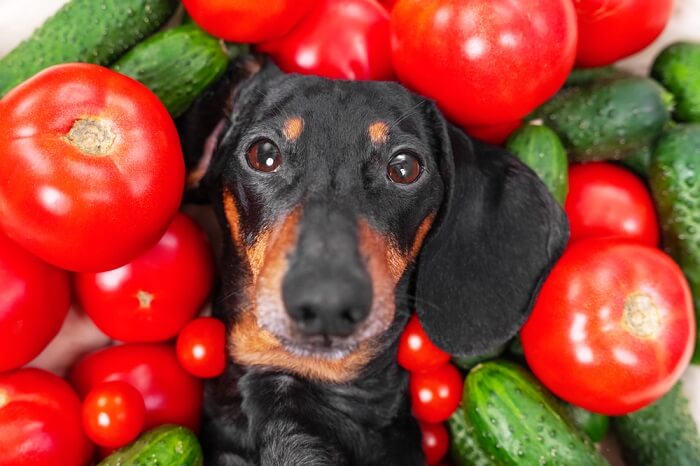
Since tomatoes are low in calories, your dog could theoretically eat a lot of them without interfering with the calories in his diet too much. However, too many tomatoes can result in an upset stomach. Tomatoes contain a lot of insoluble fiber so keep that in mind. Adding a lot of extra fiber to your dog’s diet, even in the form of a treat, can lead to diarrhea.
One medium tomato, cut into pieces, would be enough of a treat for most dogs. You could give a small dog half of a tomato, cut into pieces.
We do recommend that you consult with your veterinarian before giving your dog any new fruit or vegetable, especially if he has a pre-existing health issue.
How Often Can Dogs Eat Tomatoes?
If your dog is health and does not have any known health problems, you could give him some ripe tomatoes once or twice per week. Remember that tomatoes contain quite a bit of fiber. If your dog isn’t used to them they could lead to an upset stomach at first.
The Correct Diet Is Important
Dogs need to eat the correct diet for good health. This means that they require good quality protein and fat. Foods like tomatoes should only be given as an occasional treat. While there are many different ideas about good dog foods and different ways to feed dogs,
Here your dog needs the following in his diet:
- Good Sources of Protein- All dogs need good sources of animal protein in their diet. Meat, fish, poultry, and eggs are all good sources of animal protein.
- Good Sources of Fat- Fat provides essential fatty acids (EFA) and helps distribute the fat soluble vitamins A, D, E, and K so your dog’s body can absorb them.
- Named Ingredients- Look for named ingredients in your dog’s food and avoid generic ingredients. The more specific the ingredient is, the better. Otherwise, you don’t really know what you are feeding your dog.
- Low to Moderate Carbohydrates- Many dog foods are loaded with carbohydrates. This is true even with some good quality foods. Carbohydrates are not “bad” and they can be beneficial (dietary fiber can come from carbs, for example). But carbs should not be a substitute for protein.
- Avoid Artificial Preservatives, Colors, and Sweeteners- Artificial preservatives and colors/dyes have been linked to some health problems in humans and animals. You should try to avoid these ingredients in dog foods.
- AAFCO- AAFCO is the Association of American Feed Control Officials. AAFCO sets voluntary standards for pet food labeling. Look for foods that have these minimum standards.
- Fresh Water- All dogs need easy access to fresh water unless they are ill or have some other reason to be temporarily kept away from water. For example, if you are house training your puppy, it makes no sense to give him water overnight.
What Are Other Healthy Alternatives to Tomatoes In A Dog’s Diet?

Tomatoes are a healthy treat but there are many other fruits and vegetables that can provide some of the same benefits. You should consider these foods as treats.
Check with your veterinarian if your dog has any health issues and you are concerned about giving any of these foods.
- Apples
- Asparagus
- Bananas
- Bell pepper
- Broccoli
- Brussels sprouts
- Carrots
- Cauliflower
- Cucumber
- Green beans
- Mangos
- Oranges
- Parsnip
- Pears
- Pineapple
- Pumpkin
- Strawberries
- Summer squash
- Sweet potato
- Zucchini
How Do You Give Your Dog Tomatoes?
Most dogs love raw, ripe tomatoes. Simply cut them up and give them to your dog in a bowl. Or, you can give them to your dog from your hand. It’s usually not a good idea to let your dog eat a whole tomato without cutting it up because dogs tend to get the tomato flesh all over their faces.
If you are giving your dog tomatoes, be sure to keep the skin ON. The greatest amount of lycopene in the tomato is found in the skin.
If you make homemade sauces or other foods from tomatoes, you can also give these foods to your dog, provided they do not contain ingredients such as garlic or onions that would be harmful to dogs.
On the other hand, we do not recommend giving your dog commercial foods that contain tomatoes. These foods usually contain lots of sugar, salt, and artificial ingredients that could be harmful to your dog.
Conclusion
The ripe fruit of the tomato is nutritious and safe for dogs to eat. However, take care that you don’t allow your dog to eat the green leaves, stems, or any unripened green tomatoes. These parts of the tomato plant contain alkaloids that can be toxic to your dog in large amounts.






